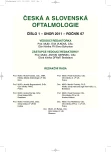Suggested Low Vision Care for Visually Impaired Children in Slovakia
Authors:
E. Gajdošová 1; E. Kukurová 2; A. Gerinec 3
Authors‘ workplace:
Clinical and Academic Department of Ophthalmology, Great Ormond Street Hospital for Children, London: Head of Dpt. Mr K. K. Nischal, FRCOphth
1; Katedra Biofyziky, Lekárska fakulta Univerzity Komenského, Bratislava, vedúca katedry prof. MUDr. E. Kukurová, CSc.
2; Klinika detskej oftalmológie LF UK, DFNsP, Bratislava, prednosta prof. MUDr. A. Gerinec, CSc.
3
Published in:
Čes. a slov. Oftal., 67, 2011, No. 1, p. 21-26
Category:
Original Article
Overview
Introduction:
There is currently no system of registration for visually impaired children in Slovakia and the current prevalence of visual impairment (VI), low vision and blindness is unknown for this population. We propose a template for a process of registration of visually impaired children in Slovakia as well as a system for the Low Vision Health Care for this population.
Material and methods:
Based on a literature search, we report our data of the estimated prevalence of VI in children in Slovakia and the number of registered students with VI. We have created a registration form and suggested a template of registration for VI children as well as the Health Care System for this population.
Results:
In industrialized countries, the prevalence of VI, including blindness is 10 - 22/10,000 in children aged less than 16 years. Extrapolating these figures to the Slovak population, we estimate that there will be between 1500 to 3200 VI children under the age of 19 years. Only 752 students with VI of this age were recorded in Slovakia in 2009/2010. We suggest that three Low Vision Centres for VI children should be adequate to cater for the VI population, each of which should provide all levels of care and that ophthalmologists should register patients with VI by filling the proposed registration form.
Conclusion:
The number of VI children in Slovakia appears to be very low. The only way of accurately assessing the prevalence is to introduce a VI registration system into the country, to be carried out by the ophthalmologists. We suggest that the Low vision service provided by the health authority needs to be divided into primary, secondary and tertiary care (including visual rehabilitation by low vision aids). Only if the Health Insurance will adequately remunerate the Ophthalmologists for the individual procedures will they be motivated enough to provide this level of health care to VI patients.
Key words:
visual impairment in children, low vision, blindness, low vision care, prevalence of visual impairment in Slovakia
Sources
1. Gajdošová, E.: Struggles of pioneer – Low Vision in Slovakia. In 7. Congress Vision 2002, Goteborg, 7/2002, s. 8.
2. Gajdošová, E.: Súčasné možnosti korekcie slabozrakosti. Atestačná práca, SZU, Bratislava, 4/2004
3. Gajdošová, E., Izák, M., Gerinec, A.: Návrh systému evidencie zrakovo postihnutých detí na Slovensku. In: Folia strabologica et neuroophthalmologica. VIII. (I, 5), 2007, s. 62.
4. Gerinec, A., Chynoranský, M., Smyková, T.: Príčiny slepoty a slabozrakosti u detí v SSR. Čs. Oftalmológia, 1990, 2: 121-127.
5. Gilbert, C., Foster, A., Negrel, A-D., et al: Childhood blindness: a new form for recording causes of visual loss in children. Bull Worl Health Organ, 1993,71: 485–489.
6. Gilbert, C. E., Anderton, L., Dandona, L., et al.: Prevalence of visual impairment in children: a review of available data. Ophthalmic Epidemiology, 1999, 6: 73–82.
7. Moravcová, D.: Zraková terapie slabozrakých a pacientů s nízkym vizem. Triton, Praha 2004, 203 s.
8. Štatistický úrad Slovenskej republiky: Bývajúce obyvateľstvo podľa pohlavia, rodinného stavu a podľa jednotiek veku. [online], [cit. 10.04.2010]. Dostupné na internete: <http://www.statistics.sk /web data/scitanie/def_sr/Data/100000/Z150__ 100000.pdf>.
9. Thylefors, B.: Avoidable blindness. Bull WHO, 1999, 77: 453.
10. Únia nevidiacich a slabozrakých Slovenska: Výročná správa 2008. [online], [cit. 05.05.2010]. Dostupné na internete: <http://unss.sk/subory/vyrocne -spravy/2008/2008-vyrocna-sprava-unss.pdf>.
11. Ústav informácií a prognóz školstva: Štatistická ročenka. [online], [cit. 08.05.2010]. Dostupné na internete: <http://www.uips.sk/ prehlady-skol/stati sticka-rocenka—-specialne-skoly>.
12. VISION 2020 Global Initiative for the elimination of avoidable blindness: Action plan 2006–2011. WHO, 2007, 1-89.
13. Výročná správa 2002, ÚNSS, Bratislava 2003, s. 7.
14. World Health Organization: International statistical classification of diseases, injuries and causes of death. Tenth revision. Geneva, 1993.
Labels
OphthalmologyArticle was published in
Czech and Slovak Ophthalmology

2011 Issue 1
Most read in this issue
- Cardiovascular Diseases Occurrence in Patients with Pseudoexfoliative Syndrome and Pseudoexfoliative Glaucoma
- Contemporary Possibilities of Artificial Vision in Blind Patients Using Artificial Neuro-prosthesis – Review
- Longterm Efficiency of a Deep Sclerectomy with T-Flux Implant
- Cataract after Lightning Injury – Case Report
